NRAO eNews
Volume 7, Issue 3
19 February 2014
NRAO eNews
Volume 7, Issue 3 • 19 February 2014

Upcoming Events

2014 Synthesis Imaging Workshop
May 13 - 20, 2014 | Socorro, NM

3rd China-U.S. Workshop on Radio Astronomy Science and Technology
May 19 - 21, 2014 | Green Bank, WV

69th International Symposium on Molecular Spectroscopy
Jun 16 - 20, 2014 | Champaign-Urbana, IL

Transformational Science in the ALMA Era: Multi-Wavelength Studies of Galaxy Evolution
Aug 04 - 07, 2014 | Charlottesville, VA
A Unique Gravitational Laboratory
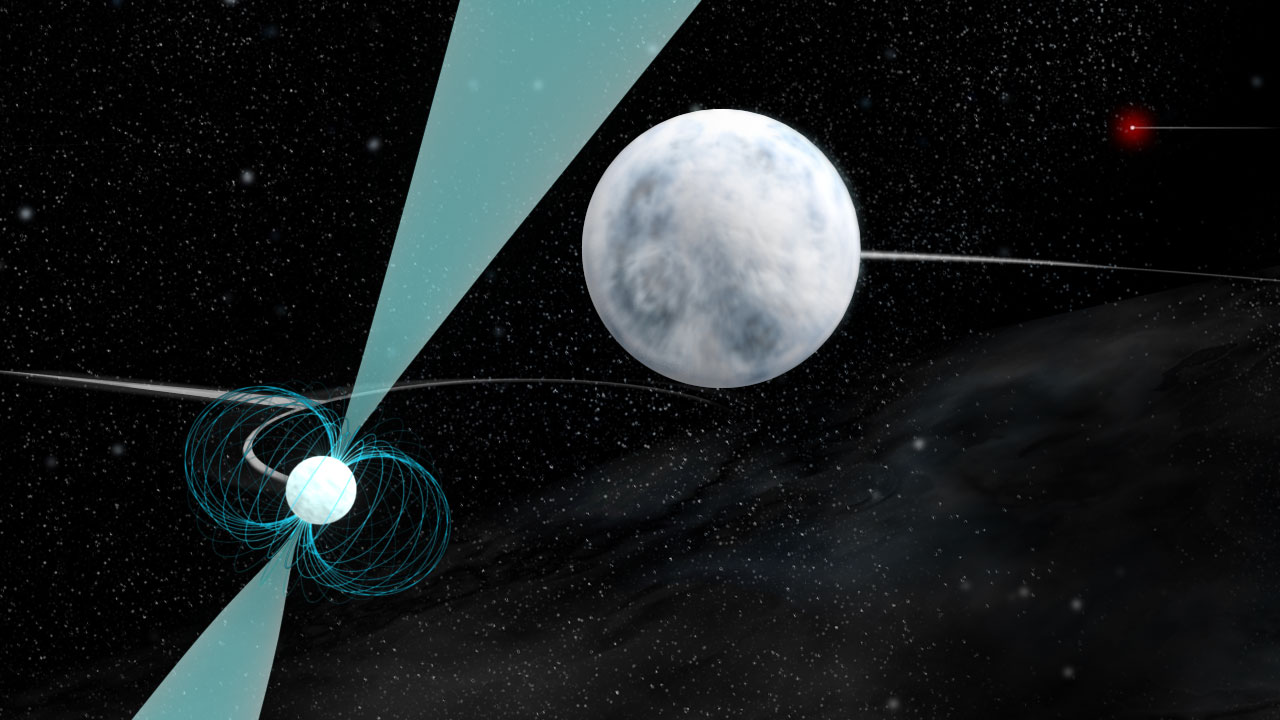
Bill Saxton; NRAO/AUI/NSF.
A millisecond pulsar (left foreground) is orbited by a hot white dwarf star (center), both of which are orbited by another, more distant and cooler white dwarf (top right).
[click to enlarge]
Gravitationally bound three-body systems show complex orbital interactions, which can constrain the compositions, masses, and interior structures of the bodies and test theories of gravity, if sufficiently precise measurements are available. A triple system containing a radio pulsar could provide such measurements, but the only previously known system, PSR B1620-26 – with a millisecond pulsar, a white dwarf, and a planetary-mass object in an orbit of several decades – shows only weak interactions.
Scott Ransom et al. recently reported precision timing and multi-wavelength observations of PSR J0337+1715, the only known millisecond pulsar in a triple system, recently discovered as part of a large-scale pulsar survey with the Green Bank Telescope. Strong gravitational interactions are apparent and provide the masses of the pulsar and the two white dwarf companions, as well as the inclinations of the orbits. The unexpectedly coplanar and nearly circular orbits indicate a complex and exotic evolutionary past that differs from those of known stellar systems. The gravitational field of the outer white dwarf strongly accelerates the inner binary containing the neutron star, and the system will thus provide an ideal laboratory to test the strong equivalence principle of General Relativity.
View Publication: A Milli-second Pulsar in a Stellar Triple System, S.M. Ransom (NRAO), I.H. Stars (UBC), A.M. Archibald (ASTRON, McGill), J.W.T. Hessles (ASTRON, Amsterdam), D.L. Kaplan (Wisconsin), M.H. van Kerkwijk (Toronto), J. Boyles (WVU, WKU), A.T. Deller (ASTRON), S. Chatterjee (Cornell), A. Schectman-Rook (Wisconsin-Madison), A. Berndsen (UBS), R.S. Lynch (McGill), D.R. Lorimer (WVU), C. Karako-Argaman (McGill), V.M. Kasi (McGill), V.I. Kondratiev (ASTRON, Lebedev), M.A. McLaughlin (WVU), J. van Leeuwen (ASTRON, Amsterdam), R. Rosen (NRAO, WVU), M.S.E. Roberts (Eureka, NYU), and K. Stovall (UT-Brownsville, UNM), published on-line by Nature, 5 January 2014.
Serendipitous Detection of a High-Redshift Luminous Galaxy
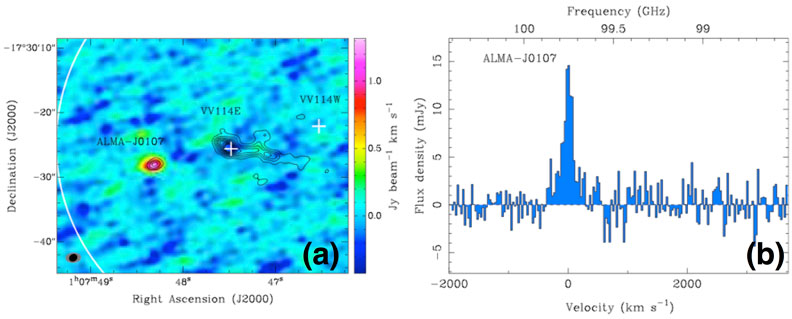
(a) An ALMA image of the CO emission from the serendipitously detected galaxy. Contours of 880µm emission are super-imposed. The plus symbols mark the positions of the near-infrared peaks associated with the foreground galaxy VV114. (b) An ALMA spectrum of the CO emission line.
[click to enlarge]
The sensitivity of ALMA opens up the possibility that many distant gas and dust-rich galaxies may be serendipitously detected in the fields of galactic or nearby extragalactic sources. Yoichi Tamura and his collaborators have made a detection of this type while analyzing recent observations of the nearby (z = 0.02) luminous infrared galaxy VV114 (2014 ApJ 781, 39). A single emission line from a background galaxy is detected at 99.75 GHz. The authors conclude, based on a photometric redshift analysis of the galaxy and both the observed frequency and the strength of the observed line, that the line is 12CO emission from a galaxy at a redshift of z = 2.467 or 3.622. Its derived molecular gas mass and far-infrared luminosities are calculated to be 8 x 1010 M⊙ and 1 x 1013 L⊙;, respectively. While the derived star formation rate is high (~ 2000 M⊙/yr) if all of the far-infrared luminosity is due to star formation, the galaxy contains a hard, luminous X-ray source that is suggestive of the presence of an AGN. The authors conclude the paper by estimating that a z > 1 galaxy with a similar CO flux to the background galaxy (> 1 Jy km/s) should be detected with the Full Science ALMA Band 3 every ~ 1000 pointings of a few minutes of more in integration time.
The VLA Sky Survey: Call to Join the Survey Science Working Groups
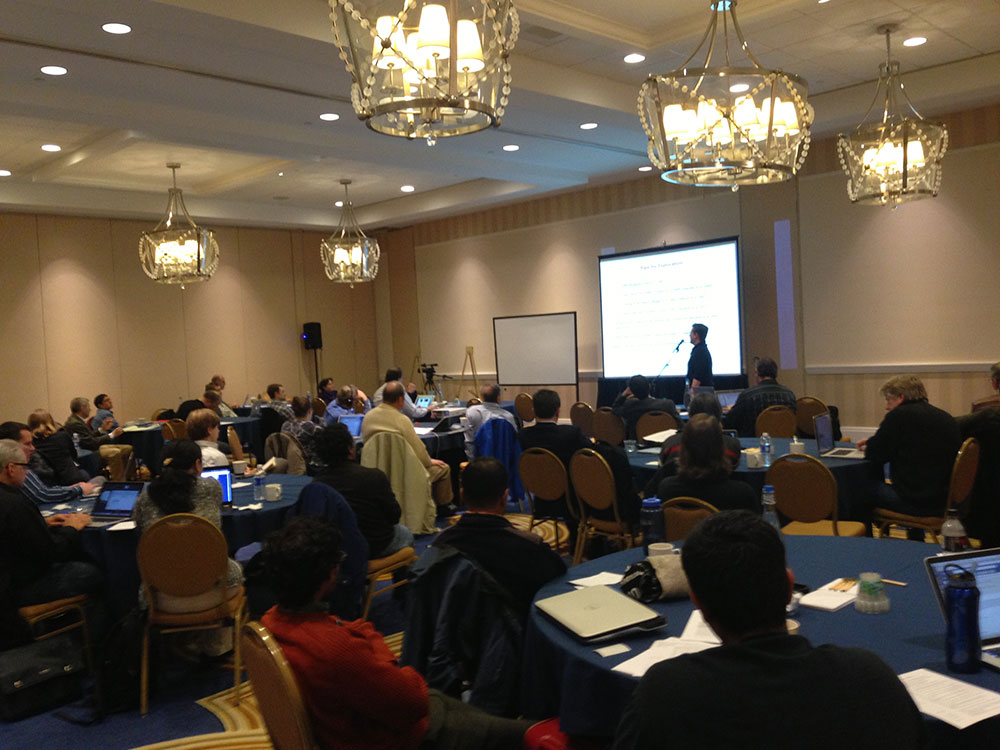
[click to enlarge]
The Science Organizing Committee of the VLA Sky Survey (VLASS), following the successful VLASS Science Planning Workshop on 5 Jan 2014 at the American Astronomical Society meeting, has formed the initial Science Survey Group (SSG), comprising a number of Science Working Groups (SWGs) that will constitute the forum for the discussions leading to the definition of the VLASS. The primary goal of the SSG is to define the survey and write the science case for the survey proposal.
The initial set of SWG categories are: Programmatics, Galactic, Extragalactic, Transients and Variables, Technical, and Communication/Education/Outreach.
All interested community members are encouraged to join one or more SWG through discussions on our NRAO Science Forums. This will be the core of the process through which the VLASS and its Science Goals will be defined, so your input is critical! The SSG will consider a wide range of issues, ranging from the key science drivers through survey technical planning, execution, data processing, and education. See the SSG webpage for more details on the SSG, the SWGs, and the process for contributing to the discussions.
To continue to receive the latest updates and information about the VLASS, please register on-line. Questions and comments can also be directed to vlass@nrao.edu
14th Synthesis Imaging Workshop
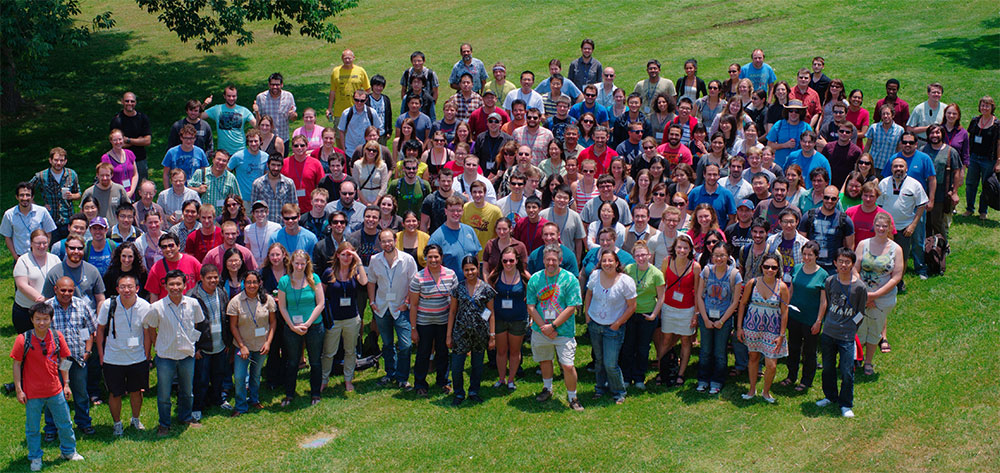
Attendees of the 2012 Synthesis Imaging Workshop
[click to enlarge]
The 14th Synthesis Imaging Workshop will be held at NRAO and the New Mexico Institute of Mining and Technology in Socorro, NM 13-20 May 2014. In addition to introductory lectures on radio interferometry, advanced topics will cover a selection of new synthesis instruments, including the Atacama Large Millimeter/submillimeter Array (ALMA), the Jansky Very Large Array (VLA), and the Long Wavelength Array. The workshop will also feature two days of hands-on data reduction tutorials, and tours of the VLA and the Science Operations Center. Workshop attendance will be limited to 150 people.
The Workshop web site provides additional information on scheduled lectures and events. If you are interested in receiving more information about the workshop, please pre-register on-line. Full registration opened 7 February, and will be on a first-come, first-served basis. Included in the registration fee is a copy of ASP Conference Series Volume 180, Synthesis Imaging in Radio Astronomy II.
Information for participants outside the US: It is our understanding of current US policy that attending a scientific workshop in the US should only require a visitor visa. Should you find you need a letter of invitation, please contact Amy Mioduszewski. Due to possible processing delays, we strongly encourage you to start paperwork early.
The Synthesis Imaging Workshop is sponsored by NRAO, the New Mexico Institute of Mining and Technology, and the University of New Mexico.
ALMA Project Status

A. Lundgren (JAO)
Fig. 1: The ALMA Array Operations Site, at 5000m elevation, hosted 62 ALMA antennas on 29 January 2014.
[click to enlarge]
All 66 of the Atacama Large Millimeter/submillimeter Array (ALMA) antennas have been delivered. Sixty-two ALMA antennas were at the 5000m elevation Array Operations Site (AOS) in late January, when the above photo (Figure-1) was taken by A. Lundgren during a visit of several ALMA Science Advisory Committee members (ASAC). The ASAC met in Santiago, Chile subsequently to discuss charges given them by the ALMA Board.
Science observations continued until 28 Jan 2014 with decreasing efficiency as the austral summer slowly intensified. Seven periods of observations of about 100 hours each have been executed, with an efficiency between 55 and 16% per session, declining with poorer weather. The next Early Science block is scheduled for early March with the array now scheduled for engineering time during expected non-optimal weather. About 35% of the estimated observation executions needed for Cycle 1 have been completed and are under analysis or have been delivered to scientists. A report on Cycle 1 observing progress will be issued on the ALMA Science Portal in March. Cycle 2 science assessments have begun and technical assessments of those is occurring in Santiago now, leading toward the 10-15 March proposal reviews in Ontario.
Results of Calls for ALMA Development Proposals
Studies: North America issued a call for proposals for ALMA development studies on 1 May 2013. Study proposals were due 12 Jul 2013. Nine submissions were received from 8 PIs with teams totaling 41 investigators from 17 institutions seeking total funding of $1.23M. Five PIs were from NRAO; the other four PIs were from other entities including one from ASIAA in Taiwan and one from National Research Council-Herzberg in Canada.
A panel of highly qualified members of the astronomical community reviewed the study proposals. To avoid conflict of interest, none of the review panel members are affiliated with NRAO. Panels submitted anonymous grades and rankings. The panel discussed the results of the rankings in a telecon. Six Studies fit within the funding envelope and were proposed for North American funding with the consent of NSF. The successful studies are listed in Table 1.
| Table 1: ALMA Development Studies | ||
|---|---|---|
Title |
Principal Investigator |
Co-Investigators |
Advanced Solar Observing |
T. Bastian, NRAO |
B. Chen (NJIT), B. De Pontieu (LMSAL), G. Fleishman (NJIT), A. Hales (NRAO), H. Hudson (USB, Glasgow), R. Hills (MRAO), G. Hurford (UCB), S. Krucker (UCB, FHNW), M. Shimojo (NAOJ), S. Wedemeyer (U. Oslo), S. White (AFRL), Y. Yan (NAO/CAS) |
2nd Generation Band10 Receiver |
A. Kerr, NRAO |
J. Mangum, S. Pan, E. Bryerton, J. Effland (NRAO), A. Lichtenberger (UVA), M. Morgan, M. Pospieszalski, K. Saini, S. Srikanth (NRAO) |
Community Science Tool Development |
A. Leroy, NRAO |
T. Robitaille (MPIA), E. Rosolowsky (UB-Alberta), M. Turk (Columbia), A. Ginsburg (ESO), C. Beaumont (Hawaii) |
2nd Generation Band 6 Receiver |
A. Kerr, NRAO |
J. Mangum, S. Pan, E. Bryerton, J. Effland (NRAO), A. Lichtenberger (UVa), M. Morgan, M. Pospieszalski, K. Saini, S. Srikanth (NRAO) |
Millimeter Camera |
S. Claude, NRC-Herzberg |
J. Di Francesco, D. Henke (NRC-Herzberg) |
Calibration Refinements for ALMA Imaging |
T. Wilson, NRL |
H. Schmidt, K. Stewart, I. Adams (Naval Research Laboratory) |
Projects: In North America, a Call for Studies of Proposed Development Upgrades of ALMA was issued 3 June 2013. The project proposals were due 16 August 2013. Eight submissions were received, submitted by PIs with teams totaling 32 investigators from 11 institutions seeking total funding of $7.01M. Three of these evolved from the previous round of Studies. Five US, three Canadian, and one Taiwanese institution were represented.
An independent panel of highly qualified members of the astronomical community, nominated by the ALMA North American Science Advisory Committee, was assembled with NSF consent on its membership. The panel reviewed the project proposals, submitting anonymous grades and rankings. After discussion at a telecon, the five most highly ranked which fit within the $4M funding available were integrated into a proposed program of ALMA Development in North America. NSF consent was received for the funding of the highest ranked proposals, and PIs were notified of their status. The proposed program for ALMA Development in North America was presented to the ALMA Director, the ALMA Development Steering Committee, and to the ALMA Board and its science advisory committee for inclusion in the ALMA Development Plan. The proposals comprising the Program are listed in the following Table-2.
| Table 2: ALMA Development Projects | ||
|---|---|---|
Title |
Principal Investigator |
Co-Investigators |
Design and Testing of a Prototype Band-2 Cartridge |
Kamaljeet S. Saini (NRAO) |
E. Bryerton (Va Diodes), Kieran Cleary (Caltech/JPL), David T. Frayer, Matthew A. Morgan, Marian W. Pospieszalski, , Scott Schnee, Sivasankaran Srikanth (NRAO), Anthony C. S. Readhead (Caltech/JPL), Lorene Samoska (JPL) |
Band 3 Cold Cartridge Assembly Magnet and Heater Installation for Deflux Operation |
S. Claude (NRC-Herzberg) |
L. Knee (NRC-Herzberg) |
Expansion of the Central LO Article to 5 Subarrays |
C. Jacques (NRAO) |
|
ALMA Data Mining Toolkit: ADMIT |
L. Mundy (U. Md) |
Jeff Kern (NRAO), Adam Leroy (NRAO), Leslie Looney (UIUC), Anthony Remijan (NRAO), Amitabh Varshney (UMd) |
The Next Generation ALMA Viewer |
E. Rosolowsky (U. Alberta) |
Jeff Kern (NRAO), Gregory Sivakoff (U. Alberta), Russ Taylor (U. Calgary / U. Cape Town) |
Transitions: Ryohei Kawabe has served as ALMA Chief Scientist since 1 June 2013. Kawabe returned to National Astronomical Observatory of Japan in December.
Jim Hesser has represented Canada on the ALMA Board for many years, and has stepped down from his duties there. Sean Dougherty will assume a seat on the Board. Thanks to Jim for his many years of alert and thoughtful work in bringing ALMA to fruition.
US-China Workshop on Radio Astronomy Science & Technology
Registration is now open for the 3rd US – China Workshop on Radio Astronomy Science and Technology-Emerging Opportunities. Those interested in developing collaborations between Chinese and US-based scientists and engineers are encouraged to participate in this workshop, which will be held at NRAO in Green Bank, WV from 19-21 May 2014. Potential areas of collaboration include Very Long Baseline Interferometry, pulsars, gravity waves, the Epoch of Reionization, HI, precision astrometry, Fast Radio Bursts, low frequency and solar radio astronomy, phased array feeds, digital technologies, spectrum management and Radio Frequency Interference excision. Particular attention will be given to new research opportunities made possible with the 65m radio telescope near Shanghai; the Five Hundred Meter Aperture Spherical Telescope (FAST); CSRH, the Chinese Spectral Radioheliograph (CSRH); a 110m fully-steerable radio telescope in western China (QTT); the Chinese Space Millimeter-Wavelength VLBI Array; and to developing a long range strategy for the development of radio astronomy in the Northern Hemisphere.
The Green Bank workshop, which follows from Memoranda of Understanding between NRAO and Shanghai Astronomical Observatory (SHAO) and between NRAO and National Observatories Astronomy China (NOAC), is being organized by NRAO and the Shanghai Astronomical Observatory and builds on the two previous joint workshops held in China in 2008 and 2013.
Registration and more information is available at the workshop website.
International Symposium on Molecular Spectroscopy
We are pleased to announce the opening of the abstract submission process for the 69th International Symposium on Molecular Spectroscopy, which will be held 16-20 Jun 2014 in Champaign-Urbana, Illinois. Abstracts will be accepted only via the symposium website until 1 March 2014.
This year, the 69th International Symposium on Molecular Spectroscopy will hold a special session titled Astronomical Molecular Spectroscopy in the Age of ALMA.
The completion and transfer to full operations of the Atacama Large Millimeter/submillimeter Array (ALMA) heralds a new era of enhancing our chemical understanding of the Universe. ALMA will cover over a decade of frequency coverage – 31 to 950+ GHz – during full science operations. With its nearly 8 GHz of instantaneous spectral bandwidth, almost all ALMA observations will uncover new chemical information in astronomical environments. This mini-symposium will highlight the capabilities of this new facility and the possibilities that await the scientific community to obtain the highest spatial and spectral resolution observations ever to better understand the chemical nature of the Universe.
We strongly encourage all researchers interested in spectral line data at all frequencies to attend this conference for an exciting exchange of ideas between chemists, astronomers and physicists. Historically, the conference has catered to young researchers presenting their first results at a science conference. As such, students are strongly encouraged to attend and give presentations.
For more information about attending and presenting at the conference, please contact Anthony Remijan or Ben McCall.
See you in Champaign!
Sandy Weinreb Receives 2014 Joseph Weber Award
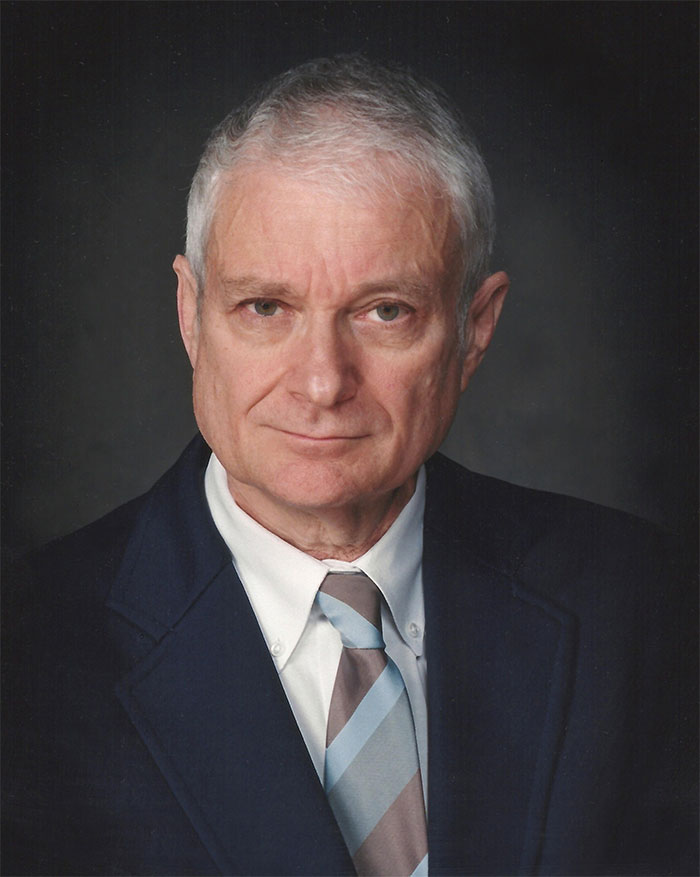
[click to enlarge]
The American Astronomical Society (AAS) has selected former NRAO Central Development Lab (CDL) Director Sander (Sandy) Weinreb to receive the 2014 Joseph Weber Award for Astronomical Instrumentation. This honor is awarded annually to an individual for the design, invention or significant improvement of instrumentation leading to advances in astronomy.
Sandy’s award citation from the AAS reads:
Sander Weinreb has been selected for the 2014 Weber Award in recognition of his seminal innovations that have helped define modern--day radio astronomy, including digital auto-correlation spectrometers and cryogenic low-noise amplifiers and mixers. In addition, he has provided outstanding leadership for radio astronomy instrumentation, especially for the electronics system of the Very Large Array. His innovations have been utilized in all radio observatories and have enabled countless astronomical discoveries.
Congratulations to Sandy on his receipt of this prestigious AAS award.
NRAO Student Awarded Chambliss Astronomy Achievement Medal
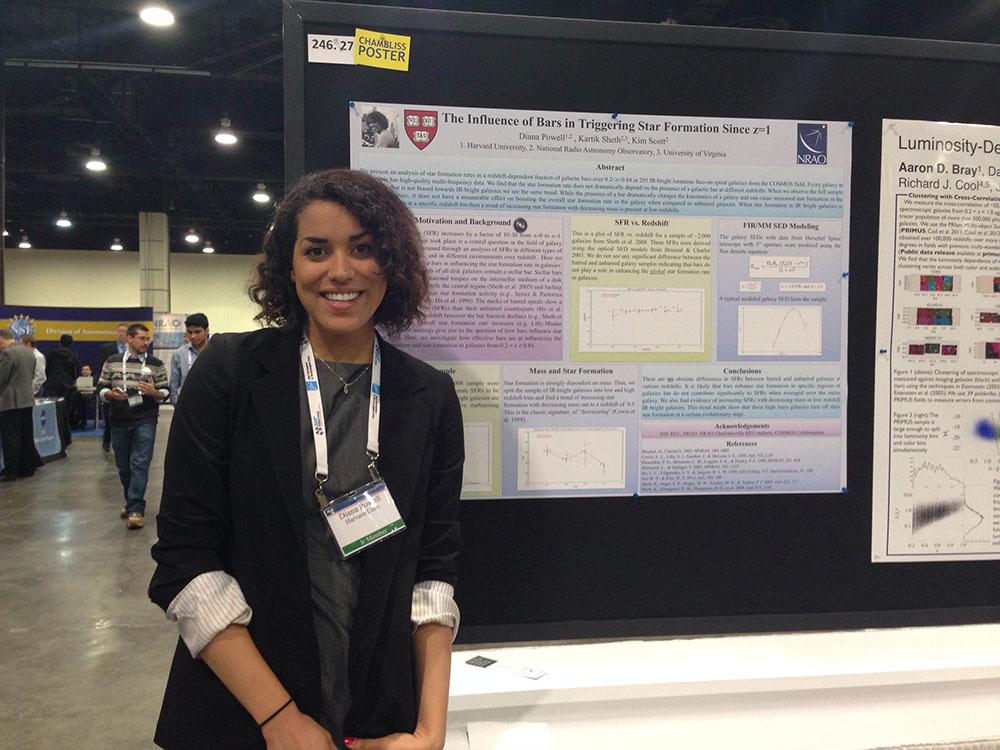
[click to enlarge]
Congratulations to Diana Powell, a Research Experiences for Undergraduates (REU) student at NRAO, for winning the Chambliss Astronomy Achievement Medal for her research and poster presentation at the 223rd American Astronomical Society (AAS) meeting. The Chambliss medals are given to recognize exemplary research by undergraduate and graduate students who present at one of the poster sessions at the meetings of the AAS. Diana is one of six undergraduate students awarded this honor.
Diana worked with Kartik Sheth and Kim Scott at the NRAO in Charlottesville during summer 2013 to study the influence of bars in triggering star formation in galaxies over the last half of cosmic history. By measuring the star formation rate (SFR) in a sample of nearly 2000 galaxies from 0 < z < 1, Diana was able to show that there are no obvious differences in the SFRs between barred and unbarred galaxies at any epoch. She concluded that while bars may enhance star formation in specific regions of galaxies, as seen in nearby objects, they do not contribute significantly to the SFR averaged over an entire galaxy. She also discovered that for low redshift, infrared-bright galaxies, the SFR increases with decreasing mass, implying that high mass galaxies turn off their star formation at earlier times.
Diana is currently a senior undergraduate student majoring in astrophysics at Harvard University. She will graduate from Harvard this spring, and will be attending graduate school in astronomy in the fall, where she plans on pursuing research in either exoplanets or star formation. Diana is also interested in becoming an advocate for the involvement of scientists in policy.
Astronomy across Africa
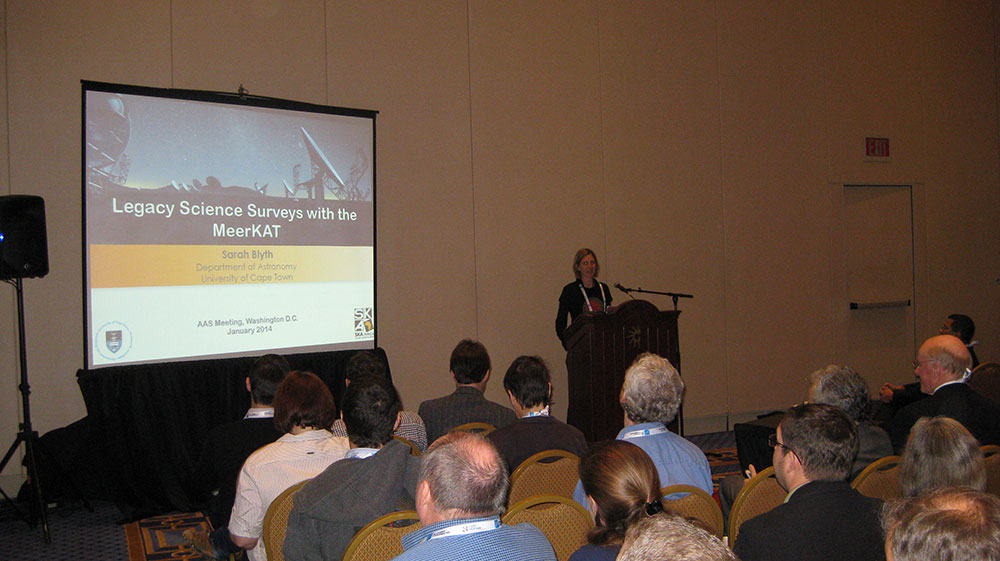
Dr. Danielle Lucero, (Cape Town)
Sarah Blyth (Cape Town) discusses Legacy Science Surveys with the MeerKAT.
[click to enlarge]
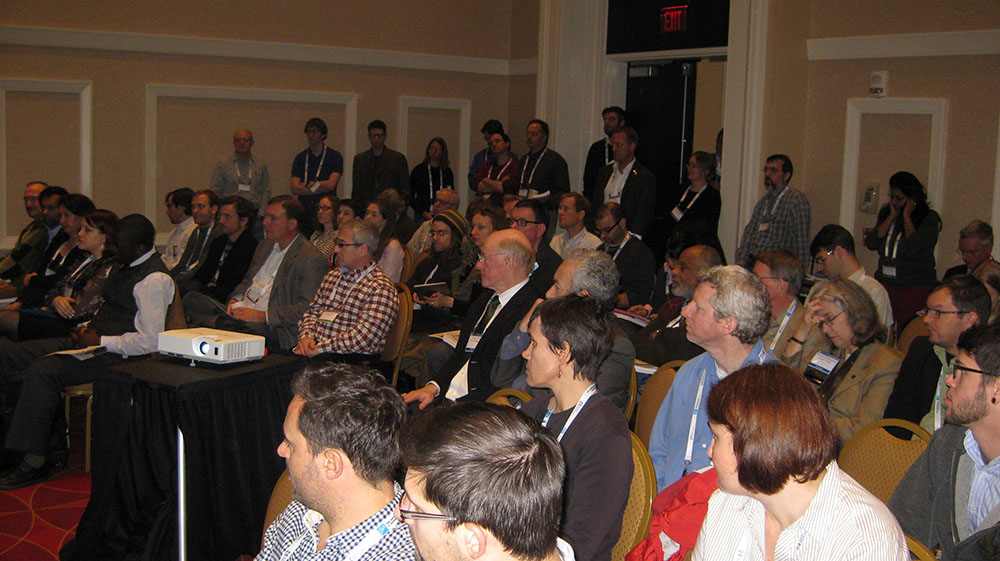
Dr. Danielle Lucero, (Cape Town)
A standing room only crowd attended the Astronomy across Africa session at the January 2014 AAS meeting.
[click to enlarge]
NRAO, in partnership with Associated Universities Inc., the National Society of Black Physicists, and the Committee for Status of Minorities in Astronomy co-sponsored a session titled Astronomy Across Africa – A New Dawn at the recent American Astronomical Society (AAS) meeting near Washington D.C. The session was envisioned and planned by Kartik Sheth (NRAO), Andrew Baker (Rutgers), and Joseph Lazio (JPL) with the main goal of introducing the AAS participants to various cutting edge multi-wavelength facilities that have are operating or are expected to be operating across the African continent: the Southern African Large Telescope (SALT), High Energy Stereoscopic System (HESS), Multifrequency Interferometry Telescope for Radio Astronomy (MITRA), African Very Long Baseline Interferometry Network (AVN), Precision Array to Probe the Epoch of Reionization (PAPER), MeerKAT, and the Square Kilometre Array (SKA).
Speakers from Africa and the US discussed on-going science activities. After an overview of astronomy across Africa by Ted Williams (Director, South African Astronomical Observatory), Ilani Loubser (UNW-Potchefstroom) reviewed the latest scientific results from SALT, Sarah Blyth (University of Cape Town) discussed new results from the KAT-7 array (pre-cursor array to MeerKAT) and also the legacy science surveys to be done with MeerKAT. Aaron Parsons (UC Berkeley) reviewed the results from their on-going exploration of the epoch of reionization with the PAPER array and the proposed Hydrogen Epoch of Reionization Array array. Kartik Sheth (NRAO) then discussed US-Africa student and faculty exchange programs that are helping to build the next generation of scientists. Following Sheth, J.C. Mauduit described the activities of the IAU Office of Astronomy Development across Africa. The session ended with brief remarks on the vision of astronomy partnerships between the US and Africa from Takalani Nemaungani of South Africa’s Department of Science and Technology.
The session was well attended: standing room only! The audience included AAS members from across the community, as well as the directors of the National Science Foundation-Division of Astronomical Sciences, NRAO, the European Southern Observatory, SAAO and SKA. The audience also included many early career astronomers. Hopefully this session will lead to further discussions on collaborations and scientific exchanges between the US and Africa. Given the large number of new radio facilities across the African continent and the long-standing partnership and new initiatives between NRAO and South Africa, the NRAO aims to lead the US community in US-Africa collaborative activities. We would like to invite all NRAO eNews readers who are interested in partnering in these activities to contact us and look for more sessions and workshops like this in the future.
Patent Issued to NRAO CDL Engineers

Prototype Integrated Receiver using the new unformatted fiber optic link
[click to enlarge]
A transformative patent will be issued to Matt Morgan and Rick Fisher of the NRAO Central Development Laboratory (CDL) in Charlottesville, Virginia. Entitled Statistical Word Boundary Detection in Serialized Data Streams, this innovative development makes it possible to transmit digital data over optical fiber, or any data link, with far less overhead in the front-end than conventional digital data links would allow.
Conventional digital links rely on rather elaborate data formatting and packetization at the transmit end to enable decoding at the receive end. By using the statistical properties of the noise omnipresent in all radio telescope observations, management of the data link can be deferred entirely to the receive end, off the telescope, with no prior formatting of the data at the transmitter, reducing the size, power dissipation, and Radio Frequency Interference (RFI) generated by the digital electronics inside the telescope.
These improvements facilitate the construction of large-format integrated focal plane arrays with the stability afforded by early digitization and digital data transmission. That stability enhances the longevity of calibrations for digitally corrected receivers, such as Phased Array Feeds (PAFs), and may prove crucial for the very high-dynamic range imaging that is key to future planned radio astronomy facilities.
Although the initial theoretical basis for the technique assumed a background spectrum of Gaussian-distributed white noise, laboratory experiments have shown that the data link is very robust in the presence of real-world signals, such as RFI, over a wide range of operating conditions. The same hardware could be applied to a broad range of sampled data streams, such as scientific and medical instrumentation, and especially imaging applications where the data rates are very large. Whether active or passive, these systems all rely on the extraction of a signal of interest from a noisy background with maximum speed and fidelity, and with minimum overhead at the sensor node.
For similar reasons, this technique would also apply to radar and sonar systems, both commercial and military, and to security screening platforms. It could also be used in industrial environments for process monitoring and product inspection. In each of these cases, the development described in this patent effectively provides system designers with an "ADC on a fiber" to incorporate in their applications for improved performance.
More information will become available in the coming weeks on the NRAO Technology Transfer website.
Highlight Your Science in an NRAO Press Release
NRAO Users: If you discover something newsworthy using one of our telescopes, our Education and Public Outreach (EPO) office would welcome the opportunity to work with you to bring public recognition to your result.
Our writers and visualizers are skilled and experienced at interpreting science for the public. They’ll work with you directly to craft a story that will express the essence of your result in an accurate and approachable way. We have extensive distribution networks and an established reputation among science journalists as a dependable source of newsworthy stories.
Our Public Information Officers are your points-of-contact:
For VLA & VLBA: Dave Finley, Socorro – dfinley@nrao.edu | +1-575-835-7302
For ALMA & GBT: Charles Blue, Charlottesville – cblue@nrao.edu | +1-434-296-0314
Recent and archived NRAO press releases can be seen on our public website. Additional information about our services, including answers to the most common questions about this service, is available at our science website.
Radio Astronomy Projects for STEM Learners

[click to enlarge]
Whether you are a science, technology, engineering, or mathematics (STEM) instructor at the university, or a STEM teacher in an elementary or secondary school, project based learning is a way to motivate learners and improve knowledge retention. And project based learning with an authentic research component has an added advantage: according to Charney et al in Cognitive apprenticeship in science through immersion in laboratory practices (2007), students who participate in authentic science experiences show significant increases in conceptual knowledge, question and hypothesis development, modeling, and logical argumentation.
The Next Generation Science Standards (NGSS) also require the integration of engineering practices into new science curriculum. As educators move toward adoption of the NGSS, radio astronomy offers a rich opportunity to integrate engineering practices into a wide variety of STEM courses.
So, if you are looking for a way to “spice” up your STEM classes, or maybe you know someone looking for a great science fair project, give these radio astronomy projects a shot. One big advantage radio has over optical telescopes is that they can be used both day and night, and on clear or cloudy days/nights.
Listening to Jupiter – The Radio JOVE project is a hands-on inquiry-based educational project that allows students, teachers and the general public to learn about radio astronomy by building their own radio telescope from an inexpensive kit and/or using remote radio telescopes through the Internet. Participants also collaborate with each other through interactions and sharing of data on the network. Visit http://radiojove.gsfc.nasa.gov/ for directions on building your own telescope and more information about participating in the project. (Cost ~$200)
Itty Bitty Telescope – The Itty Bitty telescope is a “starter” instrument that can be used to make observations of the sun, detect your own body radiation, or locate orbiting satellites. Visit http://www.gb.nrao.edu/epo/ibt.shtml for more information and directions on how to construct the telescope. (Cost ~$100)
Sudden Ionospheric Disturbance (SID) Monitor – When energy from the Sun hits the ionosphere electrons are stripped away from their nuclei, creating the ionized region in the upper atmosphere. During periods of intense solar activity – solar flare, solar storm, or coronal mass ejection – the ionosphere reacts and we can detect changes in very low frequency (VLF) transmissions from Earth. SID can detect these changes providing the opportunity to monitor what we call space weather. The data can then be submitted to the Stanford Solar Center. If you are a high school or community college educator you can receive a SuperSID for free from the Society for Amateur Radio Astronomers. For more information, visit http://solar-center.stanford.edu/SID/.
Meteor Reflection Observations – Radio meteor scattering occurs when radio waves transmitted from locations on Earth are reflected off of meteor trails. The use of this technique to monitor meteor showers is increasing in popularity. For more information on the project visit http://www.imo.net/radio and http://www.rtl-sdr.com/meteor-reflection-observations-with-rtl-sdr/. (Costs will vary, but new techniques using Software Designed Radio, or SDR, are significantly reducing the cost.)
Observe Hydrogen in the Galactic Plane – Thanks to SDR, it is now possible to observe the hydrogen in the galactic plane in both continuum and spectral modes using a dish less than 1 meter in diameter. Marcus Leech with Science Radio Laboratories, Inc. has a great article titled A 21cm Radio Telescope for the Cost-Conscious that explains the process. Visit http://www.rtl-sdr.com/rtl-sdr-for-budget-radio-astronomy/ for more information. (Cost ~$200)
Goldstone Apple Valley Radio Telescope (GAVRT) – GAVRT now offers online training free of charge. The program allows educators and students to operate a 34-meter (112-foot) radio telescope remotely via the Internet. GAVRT teaches students to use radio astronomy; to control a huge antenna, and to collect science data from objects in the Universe. In addition, the program provides curriculum, and supports classroom implementation. GAVRT uses the Internet to connect students to Mission Control and the antenna. Students are actively involved in handling data for real science applications. Visit http://www.lewiscenter.org/gavrt/ for more information.
Recent Media Releases
 |
|
 |
Starbursting in the Galaxy M82 Messier 82, the galaxy in which the nearest supernova in decades recently exploded, also is the closest galaxy that is undergoing a rapid burst of star formation, known as a starburst. Read more... |
 |
GBT Sees River of Hydrogen Using the National Science Foundation’s Robert C. Byrd Green Bank Telescope (GBT), astronomer D.J. Pisano from West Virginia University has discovered what could be a never-before-seen river of hydrogen flowing through space. Read More … |
Career Opportunities
New Postings
Deputy Program Manager: The Joint ALMA Observatory (JAO) in Santiago, Chile is accepting applications for a Deputy Program Manager. The primary purpose of this position is to provide assistance to the Program Manager in leading and managing the Program Management Group, and be responsible for some of the key activities of the group.
Software Engineer II: The NRAO in Socorro, NM invites applications for a Software Engineer II to join the development team that creates and maintains software for NRAO’s telescopes. This position is concerned primarily with updating and maintaining the software for the observation planning phase of the process. The successful applicant will perform routine maintenance and add new features to these tools.
CO-OP Student, Technical: The NRAO in Green Bank, West Virginia is seeking a CO-OP Student to work on FPGA-based data acquisition systems for experiments at the Green Bank site. The student will gain experience in designing, implementing, and testing FPGA designs, and in developing and deploying software for the control of the data acquisition instruments. This is a temporary full-time position for a period of three months.
Mechanical Engineer II: The NRAO in Socorro, NM is accepting applications for a Mechanical Engineer II responsible for the carrying out and assisting in engineering analysis, design, and general execution of a project or whole system. Responsibilities include recommendations, coordination and assisting in decisions on such aspects as design, procurement, manufacture, erection, test and some degree of initial operation.
Head of the ALMA Department of Engineering (ADE): The Joint ALMA Observatory (JAO) in Santiago, Chile is recruiting for a Head of the ALMA Department of Engineering. The incumbent will be responsible for the management and leadership of the department, for the engineering and technical staff within the JAO and for the work outcomes from those staff including Systems Integration efforts, the ongoing engineering operations of the array and overall maintenance issues. The term of appointment is three years.
Technical Specialist II: The NRAO in Socorro, NM is accepting applications for a Technical Specialist II. Under general supervision from scientists and engineers, the Technical Specialist assembles, calibrates, tests, analyzes, troubleshoots and/or repairs the Digital Transmission System and Receiver modules.
From the Archives
Ellen Bouton

[click to enlarge]
About this month's photo: February is a month of many NRAO anniversaries. The 85 foot Howard E. Tatel Radio Telescope, built in 1958 in Green Bank, was NRAO's first major radio telescope. The first 85 foot observations were made on 13 February 1959, and on 15 February simultaneous observations at 3 and 22 cm wavelengths were made – the first simultaneous observations at two separate centimeter wavelengths with a single radio telescope. When NRAO decided to build an interferometer, the Tatel Telescope became the fixed element in the NRAO 3-element interferometer system. Construction was completed on the second 85 foot telescope in February 1964 (although the cabling to connect 85-1 and 85-2 still needed to be done by NRAO staff). In February 1965, construction was completed on the 140 foot. On 11 February 1965, the National Science Foundation gave final approval to locating the 36 foot telescope on Kitt Peak. On 18 February 1976, Very Large Array antennas 1 and 2 obtained first fringes with a 1.24 km baseline. And, in February 1986, construction began at Pie Town, NM on the first Very Long Baseline Array antenna.
From the Archives is an ongoing series illustrating NRAO and U.S. radio astronomy history via images selected from our collections of individuals' and institutional papers. If readers have images they believe would be of interest to the Archives, please contact Ellen Bouton, ebouton@nrao.edu.

